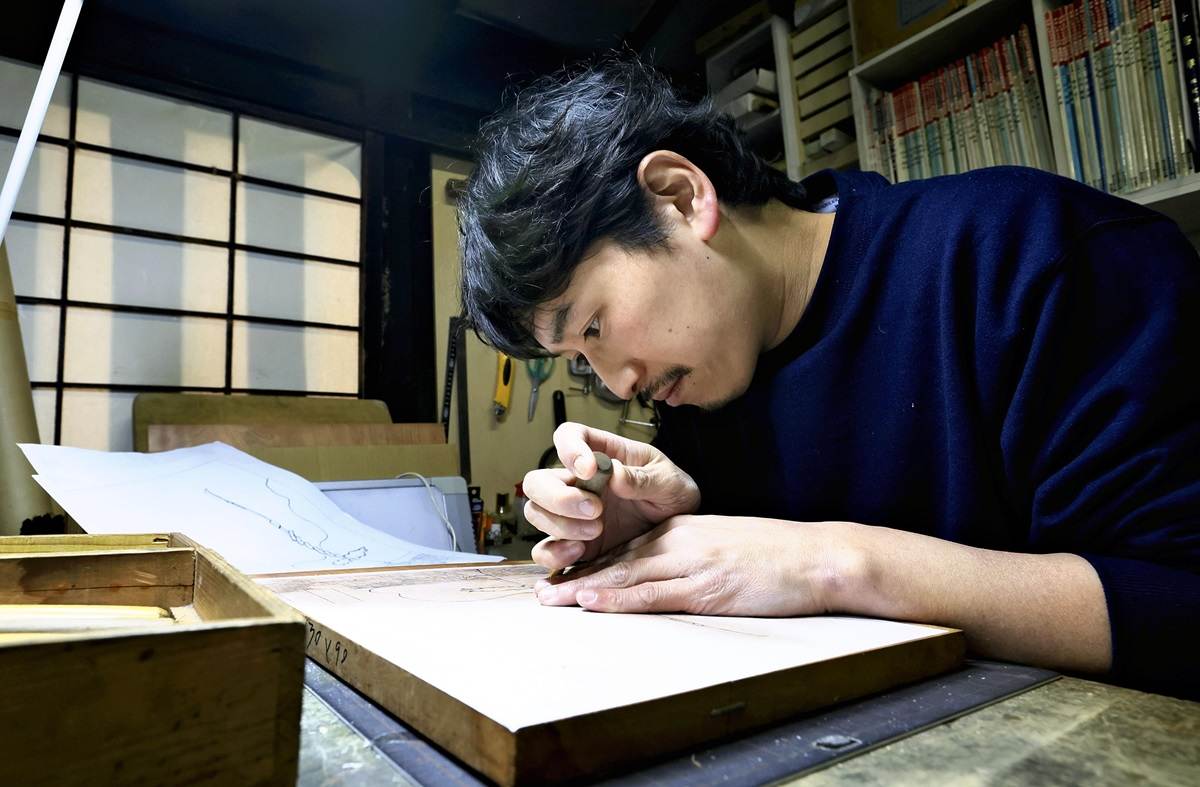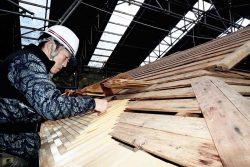Heirs to Kyoto Talent / Kyoto Woodblock Artisan Sharpens Skills with His Repeated Work

Kazuki Nojima engraves a printing block while checking the feel of the block with his hands in Shimogyo Ward, Kyoto.

11:23 JST, May 11, 2024
KYOTO — Kyo-hanga woodblock print artist Kazuki Nojima shows no hesitation as he etches lines on the surface of a printing block made from the hardwood of a mountain cherry tree. He handles the small knife masterfully as if he could already see the finished product, which will come after blocks with different colors are printed on top of one another on the paper.
Nojima said that with every stroke of engraving, he feels the hardness of the woodblock and understands with his body how to draw the lines.
“Rather than seeing, for me, I can figure out what to do by feel,” Nojima said.

A fan, book jackets and other accessories designed and produced by Takezasado
Unlike Edo woodblock prints — which are mostly ukiyo-e prints — the Kyoto version known as Kyo-hanga has been used for a wide range of items — from fans, artworks, temple and shrine paper charms to wrapping paper — encapsulating culture, entertainment and daily life.
Nojima works at Takezasado in Kyoto’s Shimogyo Ward. Takenaka Mokuhan, a woodblock printing workshop founded in 1891, established the shop to develop new methods for the modern age. In addition to reproducing classic calligraphy and paints, Takezasado makes original new works and manga-themed ones of woodblock printings. The shop also designs record jackets in collaboration with another firm.
Takezasado has from the beginning specialized in coloring and printing on washi Japanese paper. Nojima alone works on producing woodblocks with 1/10 millimeter-level precision.
Searching at art university
Nojima’s grandfather, who was an art teacher, left many oil paintings at his parents’ home in Kyoto. Nojima’s father was a craftsman in the Kyo-yuzen pattern dyeing technique.
Nojima himself became interested in painting when he was very young and went to Kyoto City University of Arts after graduating from a high school with an arts and crafts department.
Despite having studied sketching and oil painting with great enthusiasm, Nojima was unable to express what he saw even in his preferred genre of landscape painting. He dedicated himself to a wide range of activities, including kendo, rugby, theater and video production, but did not dedicate himself to painting.
Woodblock printing was among the things he thought he might be able to do if he developed the skills. Pablo Picasso and other well-known artists also created printing. Nojima tackled the art form as if trying to find an answer to a question: Why did the artists, despite being very good at other forms of expression, work on prints? Nojima said he then began to feel something new.

A reproduction of Katsushika Hokusai’s “Gaifu Kaisei” (A Mild Breeze on a Fine Day) from the “Fugaku Sanjurokkei” (Thirty-Six Views of Mount Fuji) series, top left, and printing blocks
Around the same time, Kenji Takenaka, the founder of Takezasado, was invited to teach at the university and was struck by the way Nojima worked on woodblock printing. Takenaka had an intuition as a craftsman that Nojima was “a man who manually creates things.” He employed Nojima as the first carver for Takezasado.
Broadening world
Ten years ago while in his mid-20s, Nojima began training under Hiroshi Fujisawa, a leading woodblock carver in Kyoto. The training has made it second nature for him to carve accurately and swiftly without wasted time or effort.
In his college days, Nojima was struggling to find something definite to draw. After becoming an apprentice, in contrast, his task was to create works with depth through repeated movement of his hands within shoulder width.

Nojima’s drawing of “Tower,” center, and printing blocks for the work
“The movements accumulate without any reasoning behind them. They expanded my world, instead of narrowing my vision,” Nojima said.
Woodblock prints are characterized by their homogeneity, but they also have a distinctive flair that comes from the collaboration of many people involved in the process. While being faithful to original designs, carvers create many horizontally reversed woodblocks depending on color and lines before entrusting them to craftspeople specialized in printing.
If the slightest blur in a woodblock is regarded as a failure, it’s the failure of the artisan. If it’s seen as a distinctive flair, it’s their success — that is what Nojima was told by Fujisawa. He has since kept in mind that distinctive flairs fluctuate thanks to the work’s scrupulousness.

“Tower x Tower” and printing blocks for the work
The days when woodblock prints were at the height of their prosperity are long gone, and it has been some time since the number of woodblock print artisans started decreasing.
However, the charm of woodblock prints, which is not found in digital productions or reproductions, still catches people’s attention.
“I don’t want people to think that’s because they are rare,” Nojima said. He believes that expression living today can be shared 100 or 200 years later.
***
If you are interested in the original Japanese version of this story, click here.
"Features" POPULAR ARTICLE
-

Students Recreate 19th-Century Bento Boxes Made for Ino Tadataka’s Survey Team in Hot Spring Town on Nakasendo Road
-

Santa Claus Delivers Christmas Presents to Penguins at Aquarium in Japan’s Nagasaki Prefecture
-

Sumo Restaurant in Tokyo Teaches Foreign Visitors About the Ancient Sport, with Bouts Between Retired Rikishi
-

Autonomous Passenger Ship Connects Mainland with Remote Island in Seto Inland Sea; World’s 1st Commercially Operated Autonomous Vessel
-

Osaka’s Sumiyoshi Taisha Shrine Bustles with New Year’s Visitors
JN ACCESS RANKING
-

As Chinese Tourists Shun Japan, Hotels and Stores Suffer
-

Osaka-Kansai Expo’s Economic Impact Estimated at ¥3.6 Trillion, Takes Actual Visitor Numbers into Account
-

Japan Govt Adopts Measures to Curb Mega Solar Power Plant Projects Amid Environmental Concerns
-

BOJ Gov. Ueda: Highly Likely Mechanism for Rising Wages, Prices Will Be Maintained
-

Economic Security Panels Debate Supply Chains, Rare Earths; Participants Emphasize Importance of Cooperation Among Allies

























